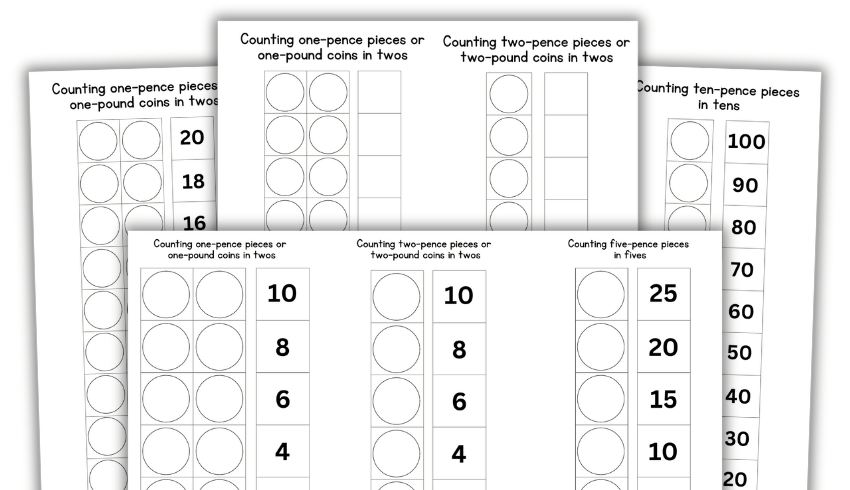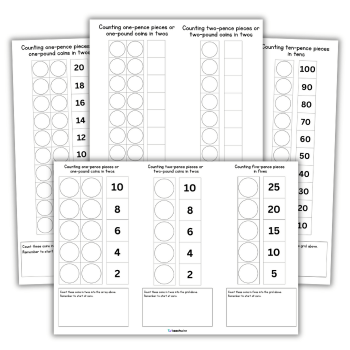Add value to your next maths lesson by using coins to teach abstract concepts. We’ve got a free set of money worksheets that will help you get started…
Year 1 curriculum
The national curriculum expects that we teach Year 1 pupils to ‘recognise and know the value of different denominations of coins and notes’. But why stop there? Why not then go on to use those coins and notes as a resource to teach other aspects of the Year 1 curriculum?
The great thing about money (apart from all the obvious stuff) is it’s as real-life as it gets when it comes to maths.
And, currently at least, it’s in a physical format; making it a ready-made, hands-on manipulative. Whether you use plastic coins and pretend notes, or real ones, money is something that pupils can hold, move around and literally get to grips with.
The benefits of using money as a manipulative to teach other areas of the maths curriculum are mutual. Teach pupils to count in ones using one-pence pieces or one-pound coins. Not only do they learn to count in ones, they also develop a familiarity with what those coins look like.
Other objectives using money
So what other objectives could we teach using money as a manipulative?
Let’s continue on the theme of counting. In Year 1, we don’t only teach children to count in ones. We also teach them to ‘count in multiples of twos, fives and tens’.
Look at those numbers – remind you of anything? Two, five and ten pence pieces, two-pound coins, five and ten-pound notes!
Remember that at this stage, although children may be able to chant “Two, four six, eight…” parrot-fashion, it is still an abstract concept to them.
So, providing them with a real-life, hands-on concrete object can begin to turn the abstract into something relatable and understandable.
Year 1 money worksheets

Try the following activities, with the accompanying money worksheets. They’ll get children using money as a representation of counting in twos, fives and tens.
Count one pence pieces or one pound coins in twos
Model the following processes to children, and then guide them to complete them themselves:
- Line up ten coins in an array (there’s another link to the national curriculum) of two by five. Using the index and middle finger, push two coins at a time to create a new array of two by five, counting in twos as it is done. You could ask additional questions such as “How many coins altogether?” once they have finished counting.
- Start with a pile of coins. Using the index and middle finger, push two coins at a time onto a pre-printed array, counting aloud in twos as it is done. You could use a two-by-five array to begin with, then two by ten to count in twos up to 20.
- Repeat the previous activity, but as the coins are moved onto the array and the twos are counted aloud, write the corresponding number next to the coin.
Similarly, these activities can then be repeated later when you move on to counting in fives and tens.
Count two pence pieces or two pound coins in twos
The focus of these activities is slightly different. Once children have counted single items in twos, you can move them on to counting items that represent the value of two while counting in twos.
Model the following processes to children, and then guide them to complete them themselves:
- Using either two-pence or two-pound coins, give children one coin at a time. As you hand the coins over, count aloud in twos together.
- Take a pile of coins. Using the index and middle finger push one coin at a time on to the multiples of two on the money worksheets, counting aloud in twos as it is done.
- Repeat the previous exercise, but start with an empty grid. As the coins are moved onto the grid and the twos are counted aloud, write the corresponding number next to each coin.
These activities can then be repeated with five-pence pieces or five-pound notes for counting in fives, and ten-pence pieces or ten-pound notes for counting in tens.
Extra challenge
This final activity works towards the end of the year once children are confident with their counting and recognition of coins and notes. It’s also a great extension for Year 2 pupils in a mixed KS1 class.
Model the following process to children, and then guide them to complete it themselves:
Start with a pile of mixed coins – either one and two pence pieces, or one and two pound coins. Count aloud in multiples of two.
Each time a multiple of two is counted, select either a two-pence piece or two one-pence pieces and move them onto the money worksheets as in the previous tasks.
Teaching children about money
With the rise of contactless payments either by card or by phone, children today are less exposed to a physical representation of money than they ever have been.
You don’t have to think that ‘cash is king’ to believe that young people need to develop a good understanding of the value of money. Whether the future uses coins or not, we know that using concrete representations helps children to learn about abstract concepts.
Although many experts call for more financial education in schools, it currently doesn’t have a foothold in the curriculum. So, right now, a maths lesson is one of the best opportunities we teachers have to help children to learn about money.
Aidan Severs is an education consultant with over 15 years of teaching experience. Visit his website at aidansevers.com. Download print off play money to use in this lesson.











